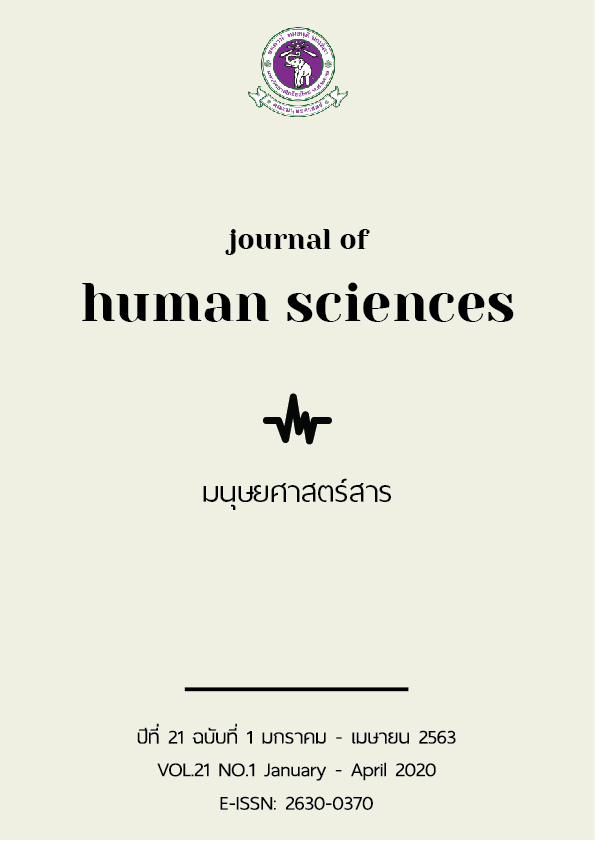การศึกษาวิเคราะห์ข้อผิดพลาดการใช้โครงสร้างกริยาซ้อน V1着V2 ของนักศึกษา สาขาวิชาภาษาจีน มหาวิทยาลัยเชียงใหม่
Main Article Content
บทคัดย่อ
งานวิจัยนี้มีจุดมุ่งหมายเพื่อศึกษาวิเคราะห์ข้อผิดพลาด สาเหตุของข้อผิดพลาดการใช้โครงสร้างกริยาซ้อน V1着V2 ที่แสดงความสัมพันธ์ทางความหมายแบบเกิดควบคู่กันของนักศึกษาสาขาวิชาภาษาจีน มหาวิทยาลัยเชียงใหม่ ชั้นปีที่ 1 ในปีการศึกษา 2559 ถึงปีการศึกษา 2561 จากแบบฝึกหัดประเภทต่างๆ ที่อาจารย์ผู้สอนมอบหมายให้ผู้เรียนทำหลังเรียนและมีการให้คะแนน ข้อสอบกลางภาคและข้อสอบปลายภาค จำนวน 262 ประโยค ผลการวิจัยพบว่าผู้เรียนเกิดข้อผิดพลาดการใช้โครงสร้างกริยาซ้อน V1着V2 ที่แสดงความสัมพันธ์ทางความหมายแบบเกิดควบคู่กันเรียงลำดับจากมากไปน้อยมีดังนี้ การใช้คำไม่เหมาะสม (พบร้อยละ 44.23) การลำดับคำผิด (พบร้อยละ 29.17) การตกหล่นคำ (พบร้อยละ 15.54) การผิดพลาดแบบซ้ำซ้อน (พบร้อยละ 9.62) และการใช้คำเกิน (พบร้อยละ 1.44) โดยสาเหตุที่ทำให้เกิดข้อผิดพลาดมี 3 ประเด็น คือ 1. การแทรกแซงของภาษาแม่ 2. ผู้เรียนไม่มีความรู้ในการใช้โครงสร้างกริยาซ้อน V1着V2 3. หนังสือเรียนอธิบายความหมายและวิธีการใช้โครงสร้างกริยาซ้อน V1着V2 ไม่ชัดเจน
Article Details
เอกสารอ้างอิง
[Clausehood in Serial Verb Constructions in Thai] (Thesis of Doctor of Philosophy
Linguistics, Chulalongkorn University).
Phanthumetha, N. (2010). Waiyakornthai. [Thai Grammar]. Bangkok: Khongkan phœiphæ
phonnganwichakan Khana′aksonsas Chulalongkon Mahawitthayalai.
Prasithrathsint, A. (1999). phasa nai sangkhom Thai: khwamlaklai kan plianplæng læ
kanphatthana [Language in Thai society: diversity change, and development]. Bangkok:
Chulalongkorn University.
Ding, J. (2001). The Semantic frame of ‘V1 zhe V2’ structure. Journal of Changde Teachers
College, 2.
Li, D. (1996). The Analysis of Errors in Using Chinese Grammar of Foreign Students. Beijing:
Beijing Language and Culture University Press.
Li, H. (2016). A Study on Serial Verb Constructions in Modern Chinese—Corresponding
Expressions in Vietnamese and Teaching suggestions (Doctoral dissertation, Shanghai
Normal University).
Li, X. & Zhang J. (2001). The Analysis of Semantics Relations in ‘V zhe V’ structure and
Semantic Features of V. Journal of Huazhong Normal University, 3.
Liu, Y. (2007). Practical Modern Chinese Grammar. Beijing: The commercial Press.
Lu, J. (1994). The Analysis of Errors in Using Chinese Grammar of Foreign Students. Language
Teaching and Research Journals, 1.
Peng, Y. (2004). Multi-angle Study of ‘V1 zhe V2’ structure (Doctoral dissertation, Huadong
Normal University)
Shen, L. (2004). A Study on Serial Verb Attributes of ‘V1 zhe + V2’ structure. Journal of
Chuxiong Teachers College, 1.
Xu, G. (2012). Development of Chinese Elementary Comprehensive (II). Beijing: Beijing Language
and Culture University Press.
Xu, W. & Zhang, D. (2002). The Analysis of Semantics Relations in ‘V1 zhe (o) V2’ structure.
Journal of Liaoning Institute of Technology, 6.
Yuan, M. (2002). A Study on Attributes of ‘V1 zhe V2’ structure. Tangdu Academic Journal, 3.
Zhao, M. (2011). The Analysis of Errors in Using Chinese Grammar of Thai Learners. Economic
Research Guide, 14.


